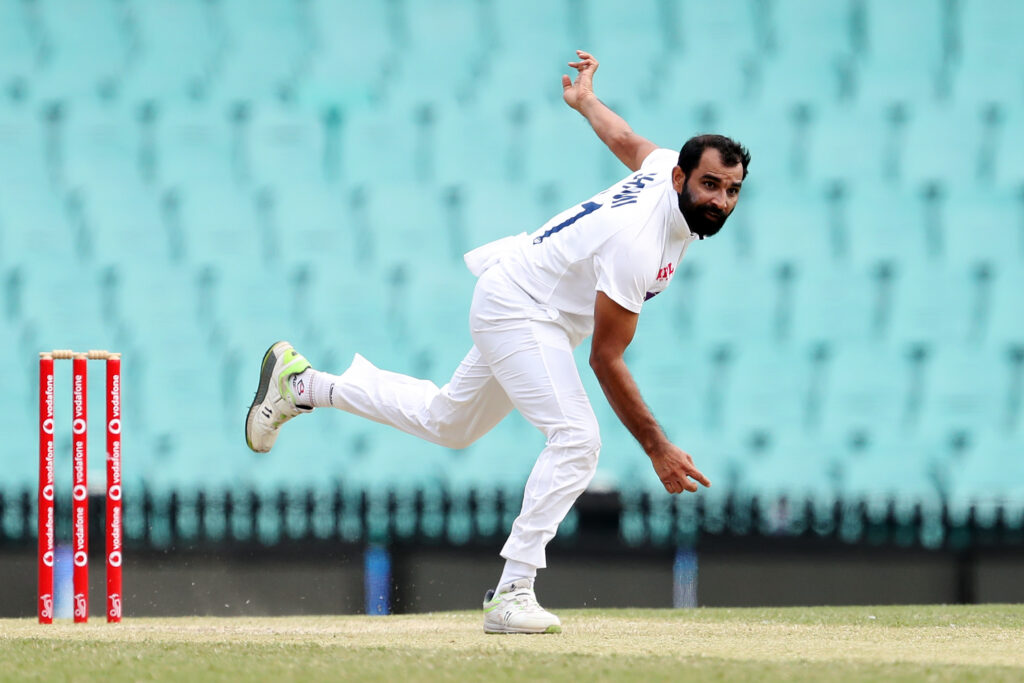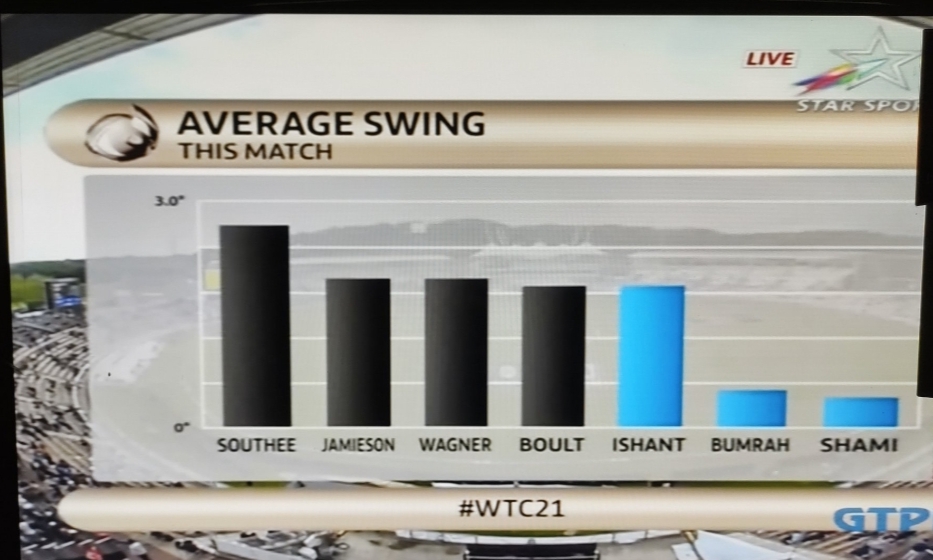
Test cricket demands that a bowler adapts to different climes. A certain bowler might be endowed with the required tools to pick up a bagful of wickets in India. However, a tour of England or Australia would offer different challenges. With the World Test Championship final against Australia to be held at The Oval in England, the Indian pace bowlers have to work out methods in their training workshops in order to pick up 20 wickets. For a few minutes, let’s peel away the outside cover to understand the bigger picture of how the Indian pace attack might go about bowling in England.
For a start, India would have to execute their plans and look to pick up 20 wickets without the services of their pace spearhead, Jasprit Bumrah. In the absence of the injured Bumrah, the responsibility of being the arrowhead of India’s pace attack would fall on Mohammed Shami. On paper, Shami has enough attributes to succeed across conditions: A combination of waspish pace, augmented by seam movement and swing. Just that, in reality, he averages 40.12 in England. Although, on a slightly positive note, his performance in the World Test Championship final against New Zealand in Southampton (2021) was noteworthy: Four wickets at an average of 26.75.
So what could be the reasons behind Shami not being able to perform up to expectations in England? There is a school of thought that Shami tends to bowl a tad short in England, beating the bat often without finding the edge. Is this hypothesis true? Let’s examine the point with a couple of live examples.
Edgbaston Test, 2022. Right after a rain break on the second day of the fifth and final Test, Shami seemed to be in his groove. One could notice his knees were pumping, he was charging to the crease and finding nifty movement in the air and off the deck. He was also using the crease brilliantly. But somehow, the wickets column didn’t change.
The first impression would be Shami was unlucky. But if we try to sift through the evidence, it can be observed that he pounded the ball on a good length/short of a length/short 23 out of the 30 deliveries (source: Text commentary, highlights package). So, if he had gone a tad fuller, he might have taken a wicket or two. It goes back to the classic old adage of Test cricket that the pace bowler has to push the batter back before delivering the knockout punch with a fuller-length ball in the corridor of uncertainty.
In 2018, at The Oval, in a nine-over spell, he beat the bat on as many as 9 occasions, but couldn’t pick up the scalp of either Alastair Cook and Moeen Ali. In that spell, Shami basically put on an exhibition of getting the ball to whistle past the outside or inside edge of the bat on numerous occasions. Once again, it could be argued that the rub of the green didn’t go Shami’s way. But it is also true that at least around 75 per cent of the deliveries in that spell were on a good length/back of a length/short. If he had gone a wee bit fuller on a few more occasions, he might have made the crucial breakthrough, but it wasn’t to be.
Shami probably believes his fuller-length deliveries could turn out to be floaty stuff, allowing the batters to cash in by bringing out drives and flicks. Simply put, it is difficult to gauge what is going on inside the bowler’s mind during a particular spell. Whatever it is, the Indian camp would be pinning their hopes on Shami to find the right length for the conditions at The Oval and live up to his billing as the leader of the attack.
Mohammed Siraj is set to be Shami’s partner-in-crime. Siraj too has enough skills in his quiver and comes across as an energetic bowler. One of his weapons that could prove to be useful in English conditions is the three-quarter seam. It is a delivery that he has employed extensively over the last four or five years. Even in the ongoing IPL, Siraj used that delivery frequently. The mechanics behind the delivery would result in the ball wobbling in the air and nipping away from the left-hand batter or into the right-hander. Occasionally, it can also straighten off the deck. The point is, as it wobbles in the air, it could befuddle the batter in relation to which way the ball would go after pitching.
As Siraj said in a press conference during the Test series against Bangladesh: “I decided to use the wobble seam because incoming deliveries are always a problem for batsmen. Because outswing is visible more clearly for the batsmen but when it comes in, then it becomes difficult for the batsmen. So I used the wobble seam because it is quite effective like an off-cutter, I trust it more because I get success from it.”

If there is a hint of moisture or grass on the first day at The Oval, it could accentuate the effect of the three-quarter-seam ball. More importantly, as the three-quarter seam ball mostly comes into the batter, Siraj could be used in short bursts against the duo of Steve Smith and Marnus Labuschagne. When the pair played in County cricket this month, there was a theory going around that they are a touch susceptible to the nip-backer. Yes, Smith found himself at the rough end of a couple of questionable LBW decisions. However, the Indian think-tank and perhaps Chesteshwar Pujara, Smith’s Sussex teammate, would be making a few notes on the Australian lynchpin’s game.
Umesh Yadav and Shardul Thakur would likely round off the Indian pace attack for The Oval Test. Umesh, who has had a niggle or two in the recent past, has a rather interesting record – home and away. He averages 37.58 abroad and 25.88 at home. The silver lining is, in the lone Test he has played at The Oval, in 2021, he finished with six wickets in the match. The little bit of extra pace the Oval deck offered probably helped his case. Umesh also swings the ball. So that opens up another conundrum for the Indian coaching staff: Whether to open the attack with Umesh and Shami, or Shami and Siraj.
Meanwhile, Shardul could be India’s fourth seamer, alongside giving the side a bit of heft with his batting ability. Shardul too has a three-quarter-seam ball in his armour. The Indian backroom staff would be hoping that Shardul doesn’t just make a few crucial incisions, but as fourth seamer, also dries up the runs with the old ball.
One of the duties of a first-change or second-change bowler in SENA countries is to keep it tight with the old ball. Shardul’s economy rate of 3.57 suggests that keeping the runs down isn’t exactly his forte. Incidentally, he went at more than six an over in the Test he played at Edgbaston last year.
This point gains significance when you observe the fact that the Indian pacers have bagged just eight wickets in the second innings of their last three overseas Tests outside Asia. It is true, in South Africa’s Highveld, the Indian pace attack was outgunned by the host’s four tall pace bowlers, who extracted more variable bounce. But even at Edgbaston, the likes of Siraj and Shardul couldn’t stitch some maiden overs and keep the pressure on Jonny Bairstow and Joe Root.
In that backdrop, with Jaydev Unadkat under an injury cloud, India could have thought of availing the services of the experienced Ishant Sharma on a short-term basis. Ever since he dismissed Sadeera Samarawickrama with a picture-perfect inswinger, in the Nagpur Test, in 2017, Ishant has been consistently generating swing. He is also renowned for bowling ‘dry’.
In fact, in the World Test Championship final in 2021, he was the only Indian bowler who matched up to the New Zealand foursome of Tim Southee, Kyle Jameson, Neil Wagner and Trent Boult in relation to finding swing in the first innings. It indicates, especially in their opening spells, that Shami and Bumrah released the ball slightly later.

On the other hand, Ishant released it relatively earlier and the resultant outcome was that he bowled fuller. But the counter argument would be that Ishant played only one first-class game in the 2022-23 season, so he could be short of match fitness as far as bowling long spells is concerned. Even though he has looked in good rhythm in the IPL, the Indian think-tank has perhaps moved on from him.
Whatever pace-spin combination India ends up picking for the WTC final, the Rohit Sharma-led side would be hoping for a bowling performance made up of control, bowling smarts and some snarl.



